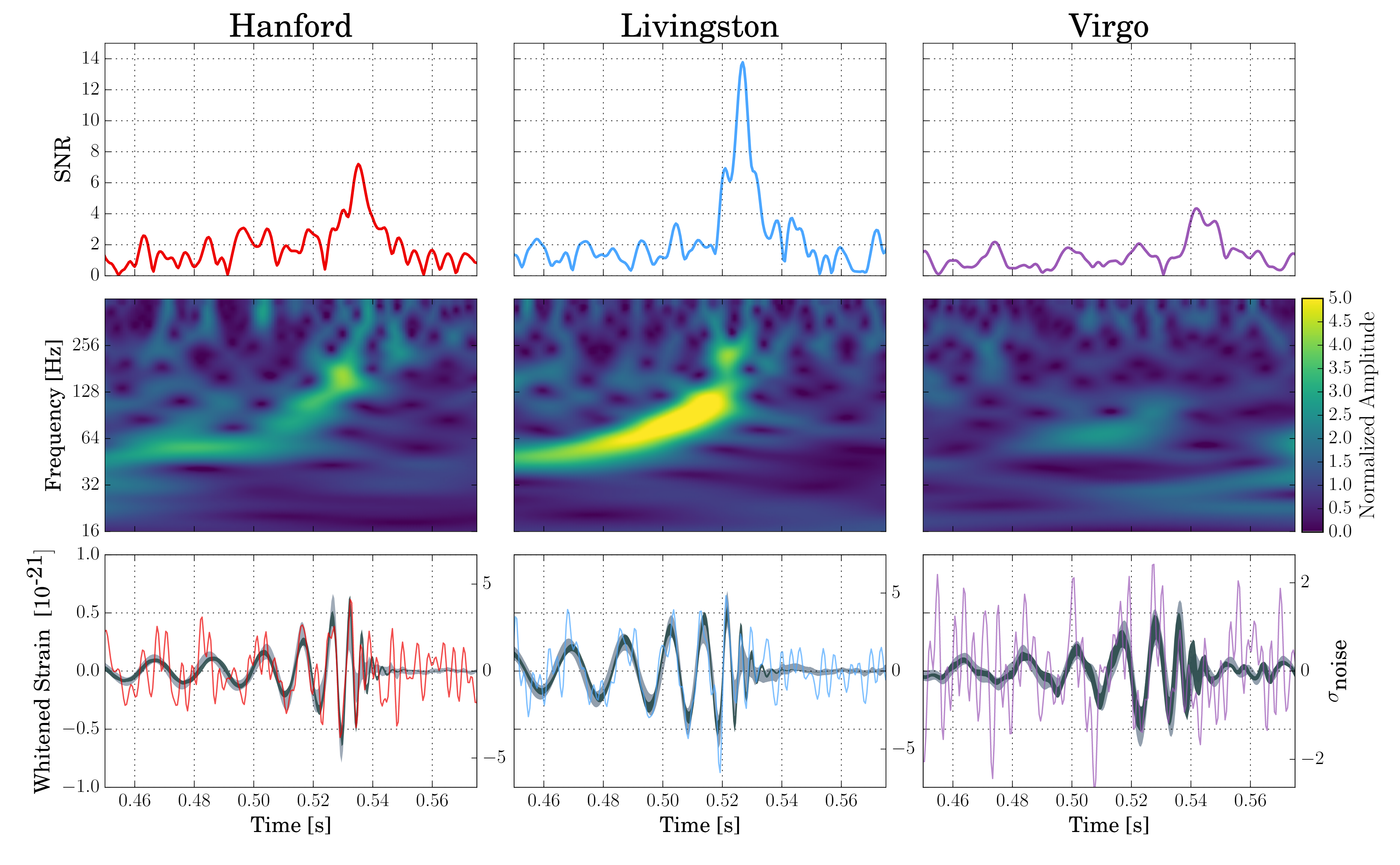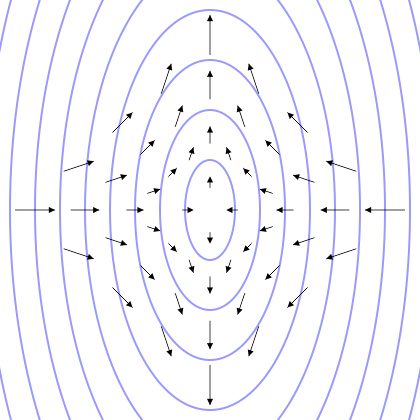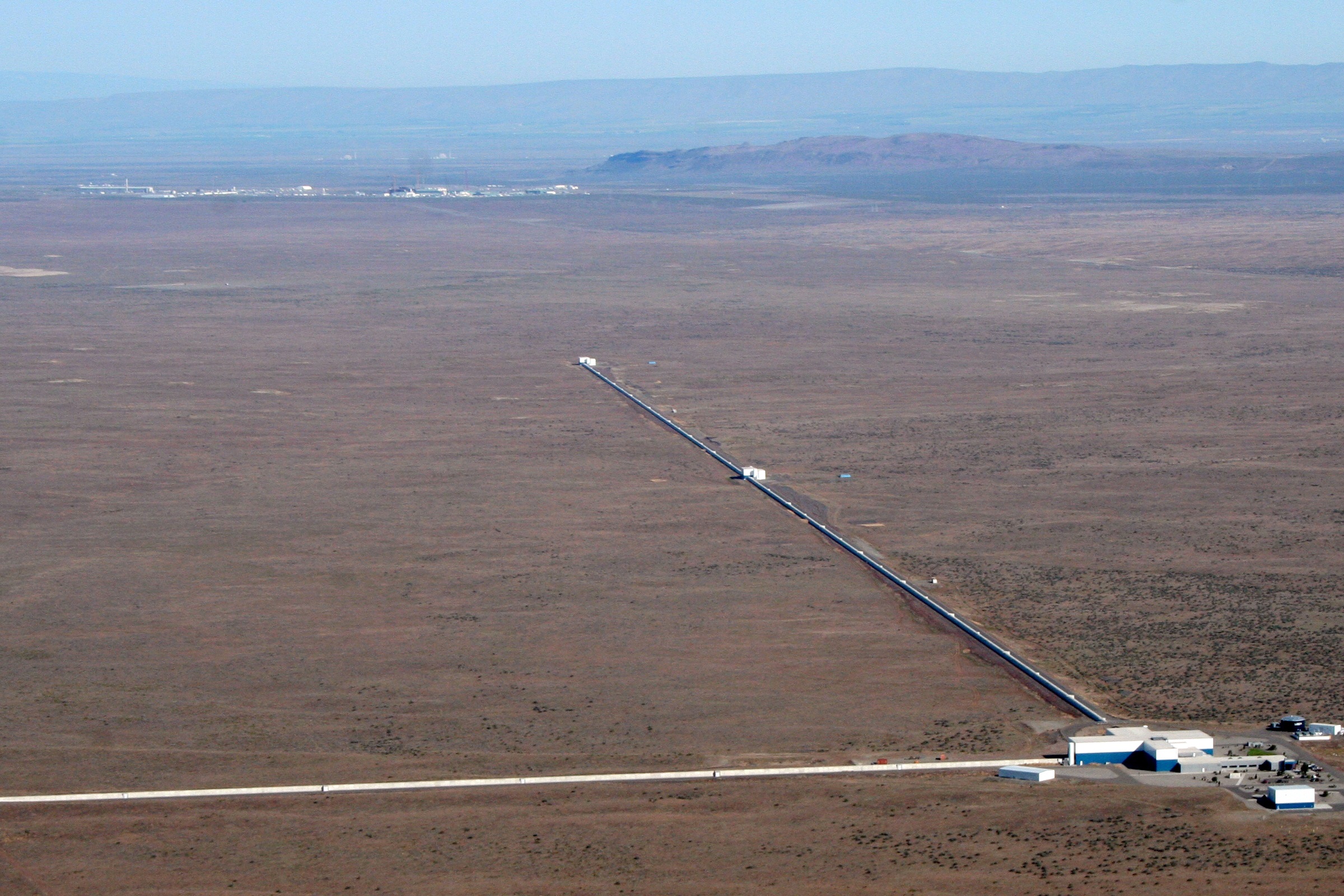|
GW170814
GW170814 was a gravitational wave signal from two merging black holes, detected by the LIGO and Virgo observatories on 14 August 2017. On 27 September 2017, the LIGO and Virgo collaborations announced the observation of the signal, the fourth confirmed event after GW150914, GW151226 and GW170104. It was the first binary black hole merger detected by LIGO and Virgo together. * Event detection left, 250px, Estimated location of GW170814. The signal was detected at 10:30:43 UTC. The Livingston detector was the first to receive the signal, followed by the Hanford detector 8 milliseconds later and Virgo received the signal 14 milliseconds after Livingston. The detection in all three detectors lead to a very accurate estimate of the position of the source, with a 90% credible region of just 60 deg2, a factor 20 times more accurate than before. Astrophysical origin Analysis indicated the signal resulted from the inspiral and merger of a pair of black holes (BBH) with and times ... [...More Info...] [...Related Items...] OR: [Wikipedia] [Google] [Baidu] |
Virgo Interferometer
The Virgo interferometer is a large interferometer designed to detect gravitational waves predicted by the general theory of relativity. Virgo is a Michelson interferometer that is isolated from external disturbances: its mirrors and instrumentation are suspended and its laser beam operates in a vacuum. The instrument's two arms are three kilometres long and located in Santo Stefano a Macerata, near the city of Pisa, Italy. Virgo is hosted by the European Gravitational Observatory (EGO), a consortium founded by the French CNRS and Italian INFN. The ''Virgo Collaboration'' operates the detector and is composed of more than 650 members, representing 119 institutions in 14 different countries. Other interferometers similar to Virgo have the same goal of detecting gravitational waves, including the two LIGO interferometers in the United States (at the Hanford Site and in Livingston, Louisiana). Since 2007, Virgo and LIGO have agreed to share and jointly analyze the data recorded ... [...More Info...] [...Related Items...] OR: [Wikipedia] [Google] [Baidu] |
2017 In Science
A number of significant scientific events occurred in 2017. The United Nations declared 2017 the ''International Year of Sustainable Tourism for Development''. Events January * 4 January ** A study published in the journal ''Science Advances'' casts further doubt on the existence of a recent " pause" in global warming, with more evidence that ocean temperatures have been underestimated. ** After 60 wins and 0 losses over 7 days, Google reveals that a mysterious player of Go, named "Master", is actually an improved version of its AlphaGo AI. ** Researchers at Michigan State University demonstrate a chemical compound and potential new drug able to stop the spread of melanoma by 90%. ** NASA announces its two choices for the next Discovery Program missions – the '' Lucy'' mission, to visit several asteroids, including six Jupiter Trojans; and the '' Psyche'' mission, to visit the large metallic asteroid 16 Psyche. * 5 January – A Japanese insurance firm, Fukoku Mutual Lif ... [...More Info...] [...Related Items...] OR: [Wikipedia] [Google] [Baidu] |
List Of Gravitational Wave Observations
This is a list of observed/candidate gravitational wave events. Direct observation of gravitational waves, which commenced with the detection of an event by LIGO in 2015, constitutes part of gravitational wave astronomy. LIGO has played a role in all subsequent detections to date, with Virgo joining in August 2017. Nomenclature and timeline Gravitational wave events are named starting with the prefix GW, while observations that trigger an event alert but have not (yet) been confirmed are named starting with the prefix S. Six digits then indicate the final two digits of the year the event was observed, two digits for the month and two digits for the day of observation. This is similar to the systematic naming for other kinds of astronomical event observations, such as those of gamma-ray bursts. Probable detections that are not confidently identified as gravitational wave events are designated LVT ("LIGO-Virgo trigger"). Known gravitational wave events come from the merger of tw ... [...More Info...] [...Related Items...] OR: [Wikipedia] [Google] [Baidu] |
Gravitational Waves
Gravitational waves are waves of the intensity of gravity generated by the accelerated masses of an orbital binary system that propagate as waves outward from their source at the speed of light. They were first proposed by Oliver Heaviside in 1893 and then later by Henri Poincaré in 1905 as waves similar to electromagnetic waves but the gravitational equivalent. Gravitational waves were later predicted in 1916 by Albert Einstein on the basis of his general theory of relativity as ripples in spacetime. Later he refused to accept gravitational waves. Gravitational waves transport energy as gravitational radiation, a form of radiant energy similar to electromagnetic radiation. Newton's law of universal gravitation, part of classical mechanics, does not provide for their existence, since that law is predicated on the assumption that physical interactions propagate instantaneously (at infinite speed)showing one of the ways the methods of Newtonian physics are unable to explain ph ... [...More Info...] [...Related Items...] OR: [Wikipedia] [Google] [Baidu] |
LIGO
The Laser Interferometer Gravitational-Wave Observatory (LIGO) is a large-scale physics experiment and observatory designed to detect cosmic gravitational waves and to develop gravitational-wave observations as an astronomical tool. Two large observatories were built in the United States with the aim of detecting gravitational waves by laser interferometry. These observatories use mirrors spaced four kilometers apart which are capable of detecting a change of less than one ten-thousandth the charge diameter of a proton. (that is, to Proxima Centauri at ). The initial LIGO observatories were funded by the United States National Science Foundation (NSF) and were conceived, built and are operated by Caltech and MIT. They collected data from 2002 to 2010 but no gravitational waves were detected. The Advanced LIGO Project to enhance the original LIGO detectors began in 2008 and continues to be supported by the NSF, with important contributions from the United Kingdom's Science a ... [...More Info...] [...Related Items...] OR: [Wikipedia] [Google] [Baidu] |
GW151226
GW151226 was a gravitational wave signal detected by the LIGO observatory on 25 December 2015 local time (26 Dec 2015 UTC). On 15 June 2016, the LIGO and Virgo collaborations announced that they had verified the signal, making it the second such signal confirmed, after GW150914, which had been announced four months earlier the same year, and the third gravitational wave signal detected. Event detection The signal was detected by LIGO at 03:38:53 UTC, with the Hanford detector picking it up 1.1 milliseconds after the Livingston detector (since the axis between the two was not parallel to the wave front); it was identified by a low-latency search within 70s of its arrival at the detectors. Astrophysical origin Analysis indicated the signal resulted from the coalescence of two black holes with and times the mass of the Sun, at a distance of megaparsecs (1.4 billion light years) from Earth. The resulting merged black hole had solar masses, one solar mass having been radiated awa ... [...More Info...] [...Related Items...] OR: [Wikipedia] [Google] [Baidu] |
General Relativity
General relativity, also known as the general theory of relativity and Einstein's theory of gravity, is the geometric theory of gravitation published by Albert Einstein in 1915 and is the current description of gravitation in modern physics. General relativity generalizes special relativity and refines Newton's law of universal gravitation, providing a unified description of gravity as a geometric property of space and time or four-dimensional spacetime. In particular, the ' is directly related to the energy and momentum of whatever matter and radiation are present. The relation is specified by the Einstein field equations, a system of second order partial differential equations. Newton's law of universal gravitation, which describes classical gravity, can be seen as a prediction of general relativity for the almost flat spacetime geometry around stationary mass distributions. Some predictions of general relativity, however, are beyond Newton's law of universal gr ... [...More Info...] [...Related Items...] OR: [Wikipedia] [Google] [Baidu] |
Stellar Black Holes
Stellar means anything related to one or more stars (''stella''). The term may also refer to: Arts, entertainment, and media * ''Stellar'' (magazine), an Irish lifestyle and fashion magazine * Stellar Loussier, a character from ''Mobile Suit Gundam SEED Destiny'' * Dr. Stellar, a Big Bang Comics superhero * '' Stellar 7'', a game for the Apple II computer system * ''Stellar'' (film), a Canadian film Music * Stellar (group), a South Korean girl group * Stellar (New Zealand band), a New Zealand-based rock band * "Stellar" (song), a 2000 song by Incubus * Stellar Awards, awards for the gospel music industry Brands and enterprises * Stellar (payment network), a system for sending money through the internet * Stellar Group (construction company), a construction company in Florida, United States * Hasselblad Stellar, a compact digital camera * Hyundai Stellar, an automobile model * O2 XDA Stellar, an HTC mobile phone Other uses * Stellar Airpark, an airport near Chandler, Arizona ... [...More Info...] [...Related Items...] OR: [Wikipedia] [Google] [Baidu] |
August 2017 Events
August is the eighth month of the year in the Julian and Gregorian calendars, and the fifth of seven months to have a length of 31 days. Its zodiac sign is Leo and was originally named ''Sextilis'' in Latin because it was the 6th month in the original ten-month Roman calendar under Romulus in 753 BC, with March being the first month of the year. About 700 BC, it became the eighth month when January and February were added to the year before March by King Numa Pompilius, who also gave it 29 days. Julius Caesar added two days when he created the Julian calendar in 46 BC (708 AUC), giving it its modern length of 31 days. In 8 BC, it was renamed in honor of Emperor Augustus. According to a Senatus consultum quoted by Macrobius, he chose this month because it was the time of several of his great triumphs, including the conquest of Egypt. Commonly repeated lore has it that August has 31 days because Augustus wanted his month to match the length of Julius Caesar's July, but ... [...More Info...] [...Related Items...] OR: [Wikipedia] [Google] [Baidu] |
Binary Stars
A binary star is a system of two stars that are gravitationally bound to and in orbit around each other. Binary stars in the night sky that are seen as a single object to the naked eye are often resolved using a telescope as separate stars, in which case they are called ''visual binaries''. Many visual binaries have long orbital periods of several centuries or millennia and therefore have orbits which are uncertain or poorly known. They may also be detected by indirect techniques, such as spectroscopy (''spectroscopic binaries'') or astrometry (''astrometric binaries''). If a binary star happens to orbit in a plane along our line of sight, its components will eclipse and transit each other; these pairs are called ''eclipsing binaries'', or, together with other binaries that change brightness as they orbit, ''photometric binaries''. If components in binary star systems are close enough they can gravitationally distort their mutual outer stellar atmospheres. In some cases, ... [...More Info...] [...Related Items...] OR: [Wikipedia] [Google] [Baidu] |




